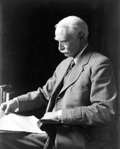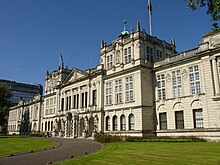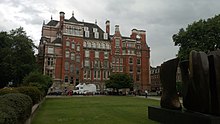W. D. Caröe

William Douglas Caröe (1857–1938) was a British architect, particularly of churches.
Early life

W. D. Caröe was born in 1857 near Liverpool in Holmsdale, Blundellsands and the youngest son of the Danish Consul in Liverpool Anders Kruuse Caröe (d. 1897) and Jane Kirkpatrick Green (d. 1877). He was educated at Ruabon Grammar School in Denbighshire, Wales before Trinity College, Cambridge, as a senior optime in the mathematical tripos of 1869[1] and graduated with a BA in 1879.[2] Caröe was articled to John Loughborough Pearson[3] and wrote the article on Pearson in the Encyclopædia Britannica, (11th ed., 1911).
He fathered two sons and a daughter with his wife Grace Desborough (d.1947). His eldest son was Sir Olaf Kirkpatric Kruuse Caröe (1892–1981) an Indian administrator followed by a daughter, Christian Desborough Caröe (1894–1973) and his youngest son Alban Douglas Rendall Caröe (1904–1991) who followed his father’s footsteps in architecture.
Biography


William Douglas Caröe was a major figure in the Arts and Crafts Movement and described as a “Master of spatial painting”.[4] He became known as "a consummate master of building according to medieval precedent".[This quote needs a citation] The firm he founded, Caroe & Partners, still flourishes, specialising in ecclesiastical architecture, especially the restoration of historic churches.[5]
Caröe was architect to numerous ecclesiastical buildings including St David's and Durham Cathedrals, and Tewkesbury and Romsey Abbeys.[5] Although Caröe primarily made his name in church architecture, he was also the architect for the Main Building of Cardiff University, inspired by his alma mater Trinity College.[6]
His own country house, "Vann" in Hambledon, Surrey, was featured on the TV series The Curious House Guest in 2006. "Vann" is open on National Gardens Scheme days and by appointment.
References
- ^ MacAlister, Ian (2005). "William Douglas Caröe". Oxford Dictionary of National Biography. Oxford University Press. Retrieved 16 September 2016.
- ^ "Caröe, William [Douglas] (CRW875WD)". A Cambridge Alumni Database. University of Cambridge.
- ^ "Caröe, William Douglas". Who's Who. Vol. 59. 1907. p. 296.
- ^ "Charismatic Caroe". RIBA. 98 (2). 1992.
- ^ a b "About Caroe and Partners architects - history of WD Caroe - Stainburn Taylor". caroe.co.uk. Retrieved 14 September 2016.
- ^ "Main Building Centenary Profile: Grand Designs". Cardiff University. Retrieved 28 October 2014.
Bibliography
- Jennifer M. Freeman (1991) W. D. Caroe: His Architectural Achievement ISBN 0-7190-2449-8
External links
- Caroe & Partners
- Entry in the Oxford Dictionary of National Biography
